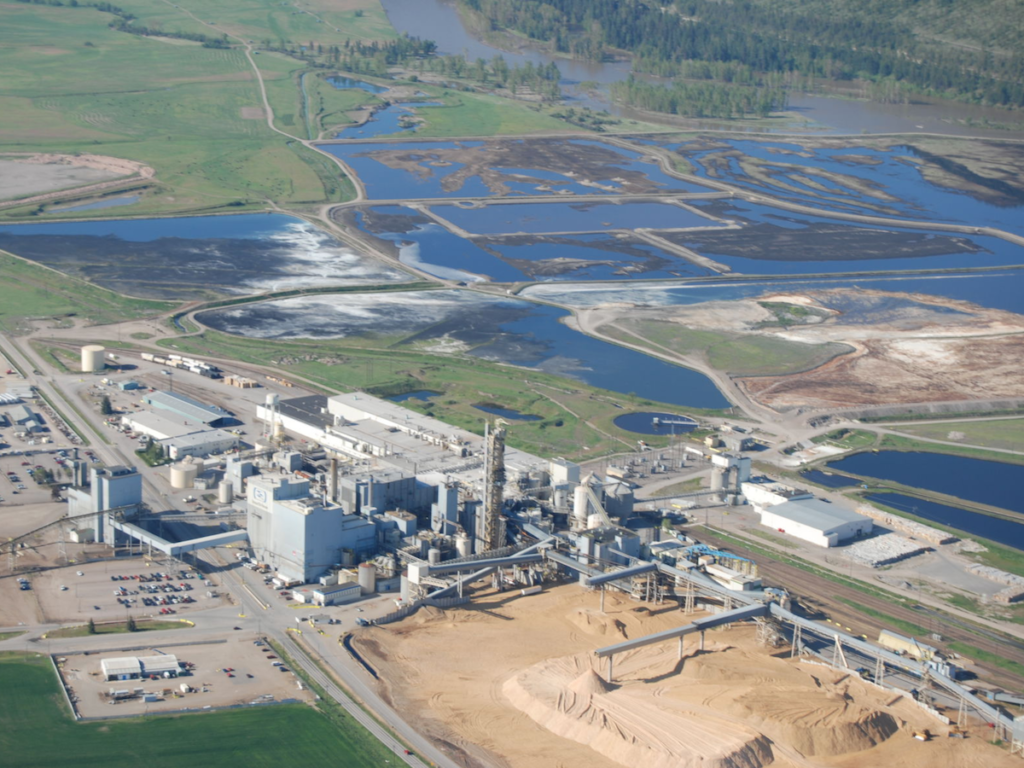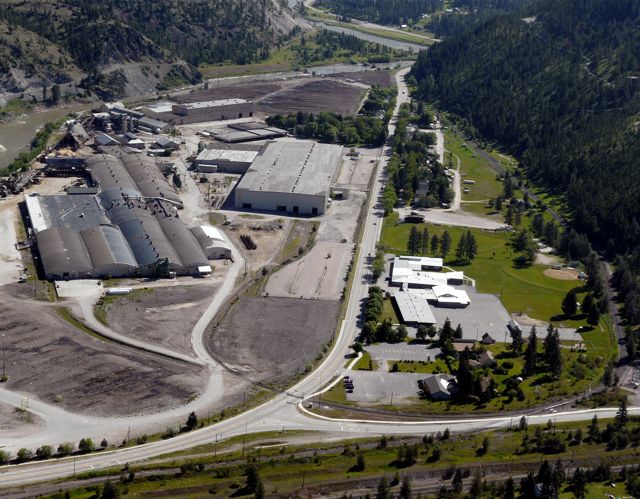
Publisher’s note: This tale of two towns that lost wood processing manufacturers is all too familiar across the country, from Maine to Arizona to Washington. The losses include tax base, jobs, school enrollment and more. The social ramifications of unemployment, families having to move, sell their homes, kids starting in a new school, stress on the parents have been documented repeatedly.
The positive and rapid evolution of new businesses at the Bonner, Montana, mill site unfortunately is the exception, while the still-vacant site in Frenchtown is more often the rule. In Bonner, the owners recruited a diversity of new businesses which reduces the vulnerability of the community to future dramatic changes. When you are dependent on one large employer, your fate rides with that one company.
There was one business that came into Bonner with roots in the past history of wood processing. It still buys small, rotten and crooked trees and keeps some of the wood products and forest management workers still going. Willis Enterprises, one of the tenants at the Bonner site, buys these low-value logs and debarks and chips them so they can be made into paper and cardboard in other locations. It processes 200,000 or more tons per year, far less than did the Smurfit-Stone plant in Frenchtown once did. Still, it represents about 7,400 truckloads of logs a year.
So in addition to the jobs of the people at the plant processing the trees, Willis supports truck drivers and equipment operators in the forest. It also means all that wood doesn’t go up in smoke from slash piles, thereby reducing air pollution, greenhouse gas emissions and contributes to the reduction of western Montana’s severe wildfire hazard.
The beer producer located at Bonner is dependent upon good clean water, so work that can help reduce the fire hazard helps protect their most important ingredient. It may not appear obvious to the casual passerby, but there is synergy between these businesses. While not as complicated as a forest ecosystem, business ecosystems can have many diverse connections.
The bark taken off the logs is back-hauled, by would-be empty trucks to Columbia Falls and used to feed the combined heat and power plant at Stoltze Lumber. The heat is used to dry the lumber and power is sold to Flathead Electric Cooperative.
Frenchtown, meanwhile, appears to be hamstrung by the critical first step of cleaning up the decades of accumulated toxic materials at the site before they can hopefully follow a similar path to a new business ecosystem there.
The following story looks at the divergent experiences in Bonner and Frenchtown after their mill closures. This story is part of a special series entitled The Montana Gap — a collaboration between High Country News and the Solutions Journalism Network.
For the next six months, the collaborating journalists will dig into the question: What are Montana communities, especially rural ones, doing to respond to help their residents weather the economic winter? And what could they learn from other communities? The project is funded by the LOR Foundation.
David Atkins, Treesource.org publisher

Bonner, Montana, in some ways, is both very similar to nearby Frenchtown and the opposite. Both were “mill towns” where the economy was largely dependent on a huge industrial site that employed hundreds of workers. Both are now small towns facing rapid growth due in part to economic development in Missoula and people seeking more affordable housing.
But one town, Bonner, was able to capitalize on its former mill site by redeveloping it with new businesses, and Frenchtown would like to do the same in the future, but faces hurdles.
In Frenchtown, the Smurfit-Stone Container Corp. closed its massive linerboard plant in early 2010 and layed off over 400 workers. That site is suspected of being heavily polluted, and the Environmental Protection Agency has been investigating it for years to determine whether it should be a Superfund site. However, it has sat dormant since it shut down and is mired in legal wranglings over culpability for cleanup by its out-of-state corporate owner.
Like Frenchtown, Bonner suffered the closure of its biggest employer when the Stimson plywood mill shut down in 2008. However, it did not sit empty under absentee ownership like the old Frenchtown mill. The Bonner mill was purchased by two local owners, Mike Boehme and Steve Nelson, who bought the 170-acre property in 2011. They have since transformed it into a thriving industrial business park, with everything from a new brewery to a concert amphitheater to a bitcoin mining operation.
“We now have in excess of 17 different companies that work out of the mill, everywhere from a two- to four-man shop to one company with 180-plus employees,” Boehme said. “There’s a total of about 450 workers out there now.”
Boehme and Nelson were successful by attracting businesses that would find a former industrial site attractive. They had huge empty warehouses to offer, security fences, lots of parking space, access to large supplies of electrical power and a close proximity to both Interstate 90 and railroad tracks.
Northwest Factory Finishes, a company that employs 40 people in a 195,000-square-foot warehouse on the site, was already a tenant when they bought the property. That company creates pre-finished building materials and ships to customers all over the country, which means dollars are flowing back to Missoula from out of state.
“It was a ghost town out here in 2009 when we first arrived here,” said company owner Britt Fred. “But working with Mike and Steve, we were able to create space, which I had to have, and the opportunity to grow. And it’s been a great relationship and we’ve worked well together as pioneers out here and now it’s great to see all the other industry that’s out here.”
Bonner’s former mill site is thriving, while Frenchtown’s mill site languishes in disrepair, mired in an environmental cleanup phase laden with legal procedures involving an out-of-state owner.
“We would give anything not to have the mill shut down and not to lose the people and families that we lost if we could get back to that level of industry,” said Debbie Lester, a Frenchtown school board member. Many former mill workers in Frenchtown left with their families to work in the North Dakota oilfield.
Even if they wanted to return and buy back the homes they once sold, they couldn’t afford to now because of rising prices.
“That’s a tragedy,” she said.
Jeri Delys is part of a group that has been regularly meeting with the EPA and other agencies to try to speed up the process of cleaning up the former Frenchtown mill site to get it back into a site of business activity. For her and others in Frenchtown, the solution to economic stagnation would be to get a large taxpaying business back in the site of the old mill like Bonner was able to do. The only way it’s going to happen is if the EPA gets the site cleaned up, so she’s encouraging her neighbors and others to get involved and attend meetings with the EPA to speed up the process.
“We’ve seen some pretty amazing growth in this area, but we have seen it dive with the loss of jobs from the mill,” Delys said. “A lot of families had to leave the area. A lot of daddies had to go work someplace else and the families suffering because of that is pretty sad to see. After the mill closed, it was a pretty devastating time for a lot of families and a lot of businesses.”
Nelson, a co-owner of the Bonner mill site, said that having the environmental remediation done by the previous owner, the Stimson Lumber Co., was a big factor in their success. Unlike in Frenchtown, the Bonner mill’s former owners agreed to perform remediation work. He also said that their strategy was to make sure they had a couple tenants in place by offering them affordable rent or land purchase options at the beginning.
“Like a lot of things, it takes one to start and then other people come along and see activity and say, ‘Wow, there is something going on here,’ and they get interested,” Nelson recalled. “We did truly also have really good help from our community, and that includes the Missoula Economic Partnership and the county. They didn’t give us anything, but they were supportive. But that was our mission, to get people in there to get started and then worry about whether we were going to charge a little more.”
Another part of their strategy was talking to all kinds of entrepreneurs and getting the word out that the place was open for business.
“We talked to everybody,” Nelson said. “We were pretty aggressive about it. My partner says we kissed a lot of frogs, but some turned out to be princes.”
Nelson said they leveraged the first few tenant’s successes to bring in other businesses by pointing out that it’s an ideal place to do business, with an almost unlimited quantity of water and transportation infrastructure. It had a sort of “snowball effect,” he said.
Nelson believes the same success can be replicated at the Frenchtown mill as long as the environmental pollution is cleaned up first. “That was the big key,” he said. “We wouldn’t have purchased the property if it wasn’t cleaned up first. Somebody has to do that before a new entity can move in.”
Nelson said the Frenchtown mill could eventually be the site of the same type of redevelopment, as could former industrial sites in places like Libby, Montana, where mining operations have left polluted but valuable land sitting vacant. “You have to get a little bit lucky, but you also gotta work hard at it and that makes you a little more lucky,” he said.
Leave a Reply